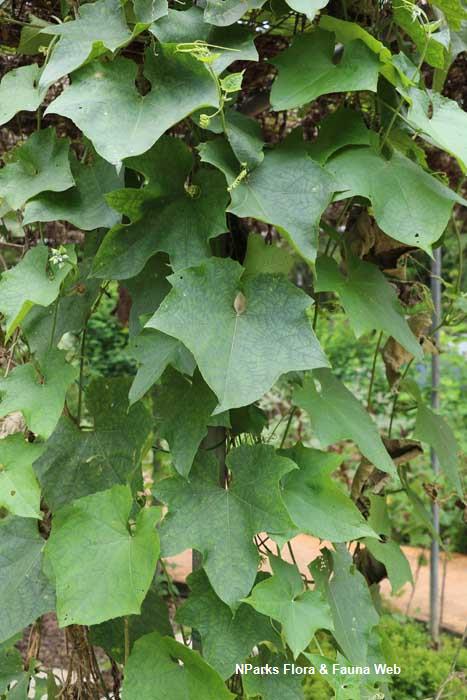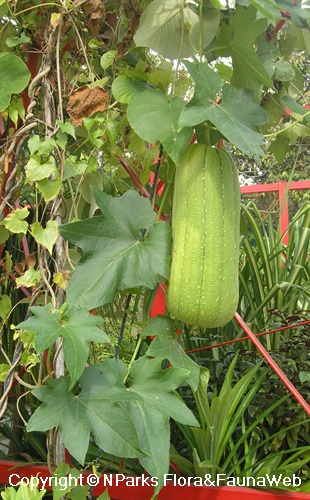
Back
Luffa aegyptiaca Mill.
| Family Name: | Cucurbitaceae |
| Synonyms: | Momordica luffa, Alsomitra cylindrica, Luffa cylindrica var. insularum |
| Common Name: | Sponge Gourd, Dish-cloth Gourd, Smooth Loofah, 丝瓜 |
There are no gourds like the Sponge Gourd! Not only can the young tasty fruit be cooked and eaten, the fibrous mature fruit can be used as a natural sponge. The high shock and water absorbency of these fibres allow for its infinite use, ranging from general cleaning, cosmetics, biofilters to machinery insulation.
Name
Classifications and Characteristics
| Plant Division | Angiosperms (Flowering Seed Plants) (Dicotyledon) |
|---|---|
| Plant Growth Form | Climber |
| Lifespan (in Singapore) | Semi-Annual / Annual-Like |
| Mode of Nutrition | Autotrophic |
Biogeography
| Native Distribution | Bangladesh, India (Assam), Bhutan, Nepal, China, Pakistan |
|---|---|
| Preferred Climate Zone | Tropical |
| Local Conservation Status | Non-native |
Description and Ethnobotany
| Growth Form | Annual herbaceous climber |
|---|---|
| Foliage | Leaves dark green, simple, palmately-lobed, rough-textured and with hairy stalks that are 5-10 cm long. |
| Stems | Stem five-angled, growing up to 15 m in length, with 2 - 6 tendrils at each point where tendrils extend. |
| Flowers | Flowers deep yellow, growing up to 5-10 cm in diameter and unisexual. Male flowers are borne on stalks on unbranched elongated inflorescences, known as racemes, while female flowers are solitary and borne in the same leaf-axils as the male flowers. Flowers open in the day. |
| Fruit | Fruit dry and fibrous, splitting from a lid-like structure, known as an operculum, located at the apex of the fruit. Subcylindrical in shape, smooth, not prominently ribbed and growing to 30-60 cm long, the fruit has a fibrous spongy skeleton network inside, containing numerous seeds that are smooth and black with a narrow wing-like margin. Green in colour when young, the fruit turns dry and brown when mature, together with the disappearance of its soft internal tissue. |
| Habitat | The genus Luffa is native to the Old World (4 species) and New World (3 species) tropics. Wild forms of L. aegyptiaca, one of the Old World species, can be found in Burma to the Philippines and southwards to north-easthern Australia and Tahiti. Now cultivated pantropically, it is not known where it was first domesticated. The plant also grows wild as an escape from cultivation. It grows best in the low humid tropics, up to 500 m altitude. However, excellent cultivars have emerged from Japan, grown during the summer season. |
| Cultivation | Rich soils with high organic matter content, good drainage and pH values of 6.5 to 7.5 are preferred. Sandy loams may also be used as a growing medium, but sufficient nutrients must be supplied. This species is intolerant of too much water, with high rainfall especially harmful during flowering and fruiting seasons. Differences in daylength sensitivity exist amongst the cultivars, there being day-neutral, short-day and long-day cultivars. |
| Etymology | Luffa, or loofah, is derived from the Arabic name, louff, while the specific epithet, aegyptiaca, means 'from Egypt' in Latin. Although this species was thought to be native to Egypt when the scientific name was assigned, scientists now consider Egypt to be outside of its native range. |
| Ethnobotanical Uses | Edible Plant Parts : Edible Fruits, Edible Leaves, Edible Flowers Food (Fruit or Vegetable): Immature fruit, young leaves and flower buds are used as vegetables. The young fruit is cooked or fried for use in soups or sliced and dried for later use. Young fruit from the sweet cultivars may be eaten raw like cucumbers or pickled if small in size. Mature fruit are fibrous, bitter and inedible, containing purgative substances. The seeds are a source of edible oil. Medicinal: The fibres, charred and fresh fruit, seeds, leaves and sap from the stem are used medicinally, particularly in Japan and China. Others: The mature fruit is the source of the loofah sponge, which has many commercially important uses. Rind and seeds are removed from the mature fruit, leaving behind the internal fibrous spongy network, which is the part that is used as the loofah sponge. During World War II, loofah sponges were used as engine filters, because Japan, the main producer of engine filters, had stopped their export. During that time, the sponge was also used in steel helmets and armoured vehicles for their shock- and sound-absorbing properties. Today, loofah sponges are used as insulating material, bath sponges, door and bath mats, insoles, sandals and even gloves. |
Landscaping Features
| Desirable Plant Features | Ornamental Flowers, Ornamental Fruits |
|---|---|
| Landscape Uses | General, Vertical Greenery / Green Wall, Container Planting |
Fauna, Pollination and Dispersal
| Fauna Pollination Dispersal Associated Fauna | Bee-Attracting |
|---|---|
| Pollination Method(s) | Biotic (Fauna) (Insects (Bee)) |
Plant Care and Propagation
| Light Preference | Full Sun |
|---|---|
| Water Preference | Moderate Water |
| Plant Growth Rate | Fast |
| Rootzone Tolerance | Fertile Loamy Soils, Well-Drained Soils |
| Propagation Method | Seed |
Foliar
| Mature Foliage Colour(s) | Green |
|---|---|
| Mature Foliage Texture(s) | Rough |
| Foliar Modification | Foliar Tendril |
| Foliar Shape(s) | Non-Palm Foliage (Palmate) |
| Foliar Venation | Palmate |
Non - Foliar and Storage
| Stem Type & Modification | Herbaceous |
|---|
Floral (Angiosperm)
| Flower & Plant Sexuality | Unisexual Flowers , Monoecious |
| Flower Colour(s) | Yellow / Golden |
|---|
| Inflorescence Type | Raceme |
| Flowering Opening Time | Daytime |
| Flower Lifespan on Plant | Several Days |
Fruit, Seed and Spore
| Mature Fruit Colour(s) | Brown |
|---|---|
| Fruit Type | Dehiscent Dry Fruit , Capsule |
Image Repository
Others
| Master ID | 30539 |
|---|---|
| Species ID | 4848 |
| Flora Disclaimer | The information in this website has been compiled from reliable sources, such as reference works on medicinal plants. It is not a substitute for medical advice or treatment and NParks does not purport to provide any medical advice. Readers should always consult his/her physician before using or consuming a plant for medicinal purposes. |










.jpg)